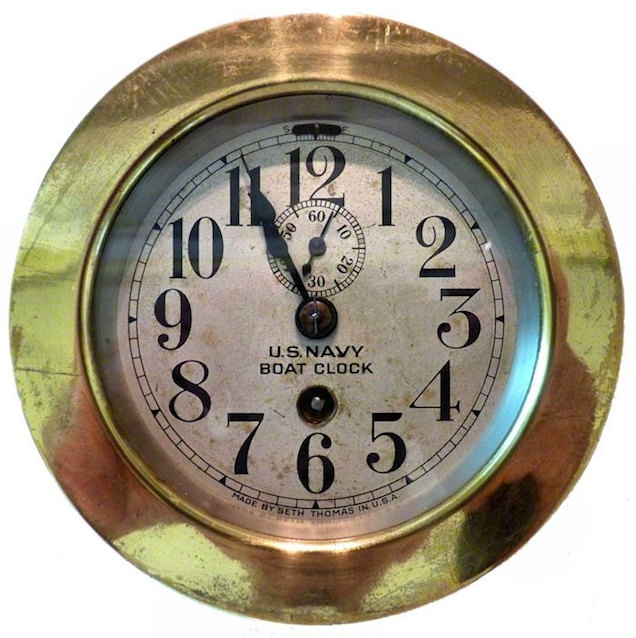Marine Clocks
Thomaston prided itself on the Seth Thomas Company's marine clocks, which kept time on U.S. Navy and merchant marine ships.
Marine clocks were useful in peacetime and essential in wartime.
Seth Thomas’s sons, who operated the company after his death, expanded production to include timepieces that used lever clock movements, such as watches and boat clocks. Lever clock movements, as opposed to pendulum and weight movements, keep time even when the clocks are not still and upright. The Seth Thomas Company purchased the patent of a lever movement from a Bristol clockmaker and built a new factory on the site of Seth Thomas’s old sawmill on Northfield Brook. The factory, built in 1865 and enlarged twice, became known as the Marine Shop because it produced the boat clocks (as well as watches and alarm clocks) with lever movements.
Seth Thomas Clocks had government contracts to supply marine clocks for the Navy. Marine clocks were equipped with bells that rang at times significant for ships. Each “watch” on board a ship lasted four hours; the clock rang a certain number of bells to indicate a change in watch and another pattern of bells every half hour.
Correct time was also necessary for navigation. According to Navy Secretary Josephus Daniels, construction of a battleship required contributions from more trades than construction of any other structure. Seth Thomas marine clocks were one of many essential technologies on Navy ships.
However, as World War I began, the United States lacked ships. President Wilson, Treasury Secretary McAdoo, Food Administration Director Hoover, and War Industries Board Chairman Baruch aimed not only to bolster America’s and the Allies’ war efforts, but also to dominate world trade after the war. America’s merchant marine had been reduced greatly by 1914. Wilson and McAdoo backed a bill that became the Shipping Act of 1916. It established the Shipping Board to purchase and construct vessels and own and operate the merchant marine. As a result, the merchant marine expanded by 4 million tons in 1917 and 1918. By the end of the war, it was 40 percent the size of Britain’s. Such growth called for many Seth Thomas marine clocks.
Marine clock production ceased at the Marine Shop when the company consolidated operations at the main Seth Thomas plant in the 1930s. However, Seth Thomas continued to supply the Navy with quality marine clocks through World War II.


